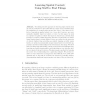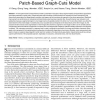103 search results - page 3 / 21 » Learning to Find Occlusion Regions |
ECCV
2008
Springer
14 years 7 months ago
2008
Springer
The sliding window approach of detecting rigid objects (such as cars) is predicated on the belief that the object can be identified from the appearance in a small region around the...
PAMI
2007
13 years 4 months ago
2007
—A novel patch-based correspondence model is presented in this paper. Many segment-based correspondence approaches have been proposed in recent years. Untextured pixels and bound...
CIVR
2006
Springer
13 years 9 months ago
2006
Springer
The problem of face detection remains challenging because faces are non-rigid objects that have a high degree of variability with respect to head rotation, illumination, facial exp...
ICALT
2005
IEEE
13 years 11 months ago
2005
IEEE
Based on our findings from an ongoing pilot with shared computers in rural primary schools in Uttar Pradesh, India since 2001 and two follow-up field studies in the same schools i...
ECCV
2006
Springer
14 years 7 months ago
2006
Springer
Occlusion and lack of visibility in dense crowded scenes make it very difficult to track individual people correctly and consistently. This problem is particularly hard to tackle i...


